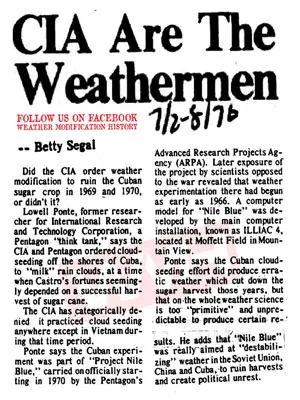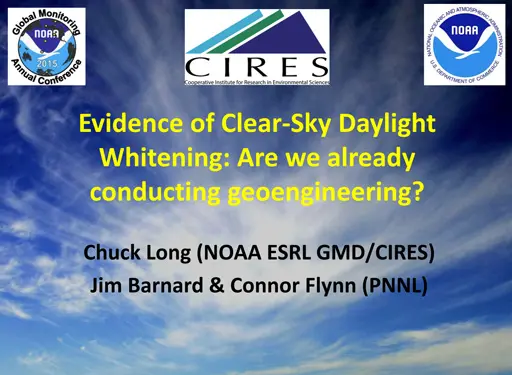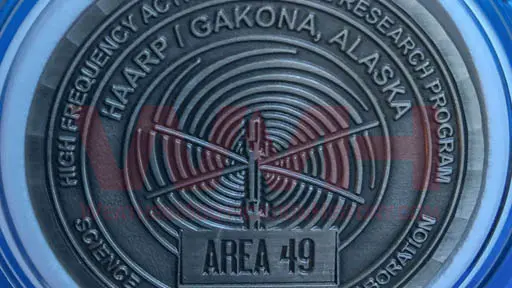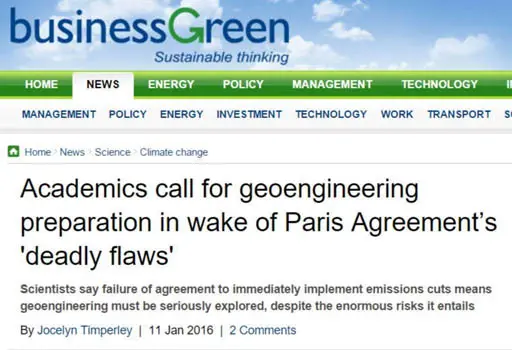
Typical radio signals will not penetrate our oceans, however Extremely Low Frequency (ELF waves) will. The United States of America previously relied on its ELF transmitters at Clam Lake, Wisconsin and Republic, Michigan (Project ELF, Project Seafarer, and Project Sanguine) to send powerful radio signals to reach submarines deep in the ocean. These transmitters used cables suspended on telephone poles, which were several miles long, and 2.6 million watts to produce a 76 Hz (45 Hz alternate) signal that could be heard over half of the Earth’s surface.

The system was controversial, and was the target of legal attacks, suits and protests throughout its operating life. On five occasions protesters cut down transmission line poles, interrupting operation briefly. In 2004 the Navy shut down both transmitters, with the explanation that very low frequency (VLF) communication systems had improved to the point that the ELF system was unnecessary.
Project ELF’s shutdown had little to do with improvements in VLF communication and all to do with the creation of the HAARP facility in Gakona, Alaska in 1993.
HAARP abandoned the long cable antennas in favor of 180 crossed-dipole antennas, 3.6 million watts, and a novel new idea: use the ionosphere to create ELF waves. HAARP focuses its antenna, called the Ionospheric Research Instrument (IRI), directly overhead where its powerful 5 billion watt output boils a portion of the sky. This boiling action causes a portion of the ionosphere to detach, which undulates in the solar wind, creating ELF waves like a massive ionospheric sub-woofer.
Researchers use ELF transmissions from the HAARP facility to create “whistler waves” that bounce around our ionosphere and remove trapped radiation that harms satellites, a process known a “radiation-belt remediation.” These whistler waves are also produced naturally when lightning strikes, and that has Stanford’s VLF group and DARPA very excited.
DARPA wants to trigger lightning to protect infrastructure, satellites, and use the artificially generated ELF waves to send messages worldwide. Lightning strikes are “triggered” at the University of Florida and University of Arizona, a network of sensors called the Holographic Array for Ionospheric Lightning (HAIL) collects info on these strikes, and HAARP has a large role in the whole process.
It is my belief that DARPA and the Stanford VLF group are using rockets, lasers, and HAARP to artificially charge thunderstorms to produce lightning strikes and subsequent ELF/ULF/VLF transmissions.
Here are the facts:

The Pentagon Launches Plan to Master Lightning
(Dec. 17) -- In Greek mythology, it was a weapon of war. Now the U.S. military is looking to tame lightning, which remains one of nature's most confounding -- and feared -- phenomena.The Defense Advanced Research Projects Agency, the R&D arm of the Pentagon, has embarked on a project called NIMBUS, which seeks to understand the underlying mechanisms of lightning. “Although significant progress has been made in recent years in our understanding of the lightning discharge and related phenomena, fundamental questions remain unanswered,” the agency said in an announcement released today.
Lightning has long perplexed scientists. Not only are atmospheric scientists unsure of exactly what initiates lightning, but they also don’t understand precisely how and why it is able to propagate over great distances, and where it will strike. That makes it, in DARPA’s view, “one of the major unsolved mysteries in the atmospheric sciences.”
The fanciful-sounding NIMBUS project has a serious goal: curbing the $5 billion in damage that lightning strikes cause each year. Lightning is not only little understood, it is dangerous and destructive – strikes cause more than $5 billion in damages annually, according to the Lightning Safety Institute. NIMBUS will look at ways to protect against that destruction, including attempting to direct where lightning strikes. The initiative also includes plans to try to trigger lightning using rockets, which could be used to model and study the discharges.
This by no means is the military’s first foray into lightning research. Pentagon officials have in the past expressed interest in other enigmatic phenomena associated with lightning, such as so-called ball lightning. Though its existence is disputed, ball lightning is purported to manifest itself as luminous, energetic spheres during storms.
The Pentagon has even funded modest efforts looking at whether ball lightning could be used as a weapon.
Another, somewhat more straightforward application of lightning, not mentioned as part of the DARPA project, is the possibility of creating a “lightning gun” – a weapon that shoots bolts of electricity. In fact, the Defense Department has funded work in this area. A Tuscon, Ariz., company called Applied Energetics (formerly Ionatron) has received a number of multimillion-dollar contracts from the Army and Navy to develop a lightning weapon that uses ultra-short laser pulses to channel electrostatic discharges. Another company, Xtreme Alternative Defense Systems, in Anderson, Ind., has built a prototype of a lightning gun, named StunStrike.
But don’t look to NIMBUS to yield a deployable death ray. DARPA says the project has a more benign goal: the protection of people and assets. [2]
Weather as a Force Multiplier: Owning the Weather in 2025
As indicated, the technical hurdles for storm development in support of military operations are obviously greater than enhancing precipitation or dispersing fog as described earlier. One area of storm research that would significantly benefit military operations is lightning modification. Most research efforts are being conducted to develop techniques to lessen the occurrence or hazards associated with lightning. This is important research for military operations and resource protection, but some offensive military benefit could be obtained by doing research on increasing the potential and intensity of lightning. Concepts to explore include increasing the basic efficiency of the thunderstorm, stimulating the triggering mechanism that initiates the bolt, and triggering lightning such as that which struck Apollo 12 in 1968. Possible mechanisms to investigate would be ways to modify the electropotential characteristics over certain targets to induce lightning strikes on the desired targets as the storm passes over their location. [3]
DARPA request for Lightning research corporate partners
Description of the Funding Opportunity: DARPA is soliciting innovative research and development (R&D) proposals on the underlying physics of lightning. Proposed research should investigate innovative approaches that enable revolutionary and fundamental advances in atmospheric and ionospheric science relating to lightning.Location: The United States is home to thunderstorms of various type, duration, scale and intensity. This program would like to capitalize on the unique geographic features of various locations across the CONUS that offer an increased likelihood of intercepting thunderstorms that exhibit unique characteristics (e.g., elevated, supercellular, multicellular, pulse, etc.).Experimental Set-up for Triggering Lightning: Bidders should fully describe how they would attempt to trigger lightning and list all potential pieces of equipment necessary to trigger lightning, as well as the equipment necessary to measure and characterize the processes governing lightning initiation, propagation, and attachment. [4]
DARPA Project NIMBUS
Lightning can cause delays in operations, disrupt communications, destroy assets, and generally pose a deadly threat to military personnel. While lightning has been studied intermittently for decades, critical questions remain about how and why lighting initiates, how it spreads, and how it attaches to objects. Also unclear is how lightning generates its ionospheric components such as elves, sprites, and gigantic blue jets, or how it ties into the global charging circuit.Nimbus is a fundamental science program focused on obtaining a comprehensive understanding of the lightning process, its associated emissions (such as x-rays), and its ionospheric components to better protect troops, ordnance, and other military assets.
This program will yield insights into other high-voltage, high-current electromagnetic phenomena. [5]
DARPA 2012 Budget Estimates
This thrust will obtain insights into physical aspects of natural phenomena such as magnetospheric sub-storms, fire, lightning, and geo-physical phenomena. A major emphasis of this thrust is to provide predictive models for the interactions between plasmas and electromagnetic waves across a range of energy and length scales, and into new regimes. Specific projects that fall under this heading are foundational studies on: the initiation, propagation, and attachment of lightning, and their associated emissions; the critical factors affecting magnetospheric sub-storms; the generation and amplification of extremely low frequency (ELF)/ultra low frequency (ULF)/very low frequency (VLF) radiation in the ionosphere utilizing the High Frequency Active Aural Research Program (HAARP) transmitter; and understanding and quantifying the interaction of electromagnetic and acoustic waves with the plasma in flames. [6]

HAARP 2010 Accomplishments:
- Initiated a series of HAARP experimental campaigns to study ionospheric and trans-ionospheric phenomena, including: optimization of high frequency to very low frequency conversion efficiency, wave-particle interaction, generation and propagation of ultra low frequencies, very low frequencies and artificial ducts, triggering and characterization of specific ionospheric instabilities.
- Developed theoretical models for triggered lightning, transient luminous events, lightning-induced electron precipitation and related ionospheric phenomena.
- Developed theoretical models for lightning initiation, propagation, and attachment.
- Investigated unexpected, GPS-derived total electron enhancements (25 percent larger than previously observed) and overshoots and the mechanisms behind these phenomena, which may provide significant insight into artificial ionization caused by descending plasma plumes.
- Conducted a comprehensive series of ELF/ULF/VLF generation experiments and accomplished first ever generation of ELF waves (10-50 Hz) without the presence of a Polar Auroral electrojet using the ionospheric current drive (ICD).
- Characterized ionospheric current drive (ICD), artificially stimulated emissions in the ionosphere, and ionospheric turbulence and associated scintillations.
- Developed and implemented a continuously-operational, comprehensive array of instruments that measure emissions generated by tropospheric lightning, the associated electric and magnetic fields, and the appropriate time derivatives of these fields which indicate how rapidly they change.
- Discovered potential correlation between compact intracloud discharges (CIDs) and gigantic blue jets (leaders that extend up to 35 km in altitude).
- Deployed balloons into thunderstorms to make in-situ electric field, X-ray and gamma-ray measurements.
- Characterize conditions surrounding artificial duct creation and conduct experiments to determine mechanisms by which VLF waves can be injected into these ducts.
- Conduct a series of experiments to quantify D-region absorption, F-region irregularities, spatial distribution of ELF/VLF source currents, and Electrojet electric fields.
- Conduct a series of experiments to optimize the efficiency of ULF generation and potentially gain active control of their lateral propagation paths and injection into the magnetosphere.
- Conduct comprehensive research campaigns using both triggered and natural lightning during the fall/winter storm seasons to measure all atmospheric, electromagnetic and ionospheric phenomena associated with positively-charged-winter-time lightning.
- Conduct comprehensive fall/winter research campaigns to study the initiation of transient luminous events, early VLF events, and lightning-induced electron precipitation events by providing the known event timing, location, and properties inherent to rocket-triggered lightning.
- Conduct comprehensive HAARP-ULF experiments to study the onset of noise under a variety of space-weather conditions.
- Conduct a series of experiments to inject VLF waves into artificial ducts.
- Develop, implement and test a continuously-operational, extensive array of instruments which will measure all atmospheric and electromagnetic components of tropospheric lightning and correlate this phenomenon with various ionospheric events.
- Deploy balloons into thunderstorms to make in-situ electric field, X-ray and gamma-ray measurements.
- Develop and deploy a constellation of receivers to study the radio emissions generated by lightning and associated ionospheric events.
- Conduct numerical studies of ion dynamics caused by ULF, and of VLF wave propagation through the ionosphere inside density ducts created by artificial heating.
- Experimentally attempt 3-D observations of HF-induced plasma structures and potentially determine relative HF power absorption for different altitudes, frequencies and geophysical conditions.
- Experimentally quantify the impact of triggered lightning on properties of natural lightning (including the emission of gamma rays, X-rays, UV, VNIR/SWIR, RF, VLF/ULF) and on the properties of ionospheric phenomena (elves, sprites, whistlers, etc.).
- Experimentally quantify the impact of tropospheric lightning (both triggered and natural) and its ionospheric components on the conductivity of the ionosphere and the resultant scattering of sub-ionospherically-propagating VLF signals.
- Experimentally quantify the impact of CIDs on lightning propagation as well as their potential contribution to the production of very large blue jets. [7]
University of Florida Lightning Research Group - Rocket-Triggered Lightning
The International Center for Lightning Research and Testing (ICLRT) at Camp Blanding, FloridaIn October 1994, the University of Florida and Camp Blanding Florida Army National Guard Base signed an agreement forming the International Center for Lightning Research and Testing (ICLRT) for the purpose of advancing the science and technology of lightning. The Center occupies over 100 acres at Camp Blanding, about 45 km north-east of Gainesville, Florida. Airspace is controlled at Camp Blanding so that lightning initiation from overhead thunderclouds using the rocket-and-wire technique can be routinely performed and the resulting triggered lightning studied, in addition to the study of nearby natural lightning (an average of 5 to 6 natural lightning strikes occur on the site each summer). In February 1995, The Electric Power Research Institute (EPRI) donated $1,500,000 (original value) of measurement and other equipment (including six Nicolet digitizing oscilloscopes) to the Center. In May 1997, the University of Florida (UF) in Gainesville donated and installed a 2500 square foot mobile home (value $40,000) to the Center in order to make available both research and living space for UF and visiting investigators. During summers 1995 to 2007 over 40 researchers (excluding UF faculty, students and staff) from 15 countries representing 4 continents have performed experiments at the Center concerned with various aspects of atmospheric electricity, lightning, and lightning protection. Since 2005, the ICLRT has been operated jointly by the University of Florida and the Florida Institute of Technology (FIT). [8]Projects:
- Lightning Initiation, Propagation, Attachment, and Ionospheric Effect, 2010-2014, DARPA.
- Lightning: Electromagnetic Environment and Source Parameters, 2009-2014, NSF.
- Lightning and Propagation, 2009-2010, US Dept. Defense/DARPA.
- Lightning Research and Testing at Camp Blanding, 2009-2010, NASA.
- A Characterization of the Close Electric and Magnetic Fields and Thunder of Lightning from the UF Multiple Station Experiment, 1999-2010, Department of Transportation, Federal Aviation Administration.
- Update Direct-Strike Lightning Environment for Stockpile-to-Target Sequence Supplement LLNL - Contract #B568621, 2007-2010, Lawrence Livermore Laboratory.


'Dressed' laser aimed at clouds may be key to inducing rain, lightning
UCF, Arizona researchers extend length of high-intensity laser with hope of stimulating showers
The adage "Everyone complains about the weather but nobody does anything about it," may one day be obsolete if researchers at the University of Central Florida's College of Optics & Photonics and the University of Arizona further develop a new technique to aim a high-energy laser beam into clouds to make it rain or trigger lightning.The solution? Surround the beam with a second beam to act as an energy reservoir, sustaining the central beam to greater distances than previously possible. The secondary “dress” beam refuels and helps prevent the dissipation of the high-intensity primary beam, which on its own would break down quickly. A report on the project, “Externally refueled optical filaments,” was recently published in Nature Photonics.
Water condensation and lightning activity in clouds are linked to large amounts of static charged particles. Stimulating those particles with the right kind of laser holds the key to possibly one day summoning a shower when and where it is needed.
Lasers can already travel great distances but “when a laser beam becomes intense enough, it behaves differently than usual – it collapses inward on itself,” said Matthew Mills, a graduate student in the Center for Research and Education in Optics and Lasers (CREOL). “The collapse becomes so intense that electrons in the air’s oxygen and nitrogen are ripped off creating plasma – basically a soup of electrons.”
At that point, the plasma immediately tries to spread the beam back out, causing a struggle between the spreading and collapsing of an ultra-short laser pulse. This struggle is called filamentation, and creates a filament or “light string” that only propagates for a while until the properties of air make the beam disperse.
“Because a filament creates excited electrons in its wake as it moves, it artificially seeds the conditions necessary for rain and lightning to occur,” Mills said. Other researchers have caused “electrical events” in clouds, but not lightning strikes.
But how do you get close enough to direct the beam into the cloud without being blasted to smithereens by lightning?
“What would be nice is to have a sneaky way which allows us to produce an arbitrary long ‘filament extension cable.’ It turns out that if you wrap a large, low intensity, doughnut-like ‘dress’ beam around the filament and slowly move it inward, you can provide this arbitrary extension,” Mills said.
“Since we have control over the length of a filament with our method, one could seed the conditions needed for a rainstorm from afar. Ultimately, you could artificially control the rain and lightning over a large expanse with such ideas.”
So far, Mills and fellow graduate student Ali Miri have been able to extend the pulse from 10 inches to about 7 feet. And they’re working to extend the filament even farther.
“This work could ultimately lead to ultra-long optically induced filaments or plasma channels that are otherwise impossible to establish under normal conditions,” said professor Demetrios Christodoulides, who is working with the graduate students on the project.
“In principle such dressed filaments could propagate for more than 50 meters or so, thus enabling a number of applications. This family of optical filaments may one day be used to selectively guide microwave signals along very long plasma channels, perhaps for hundreds of meters.”
Other possible uses of this technique could be used in long-distance sensors and spectrometers to identify chemical makeup. Development of the technology was supported by a $7.5 million grant from the Department of Defense. [10]
![New Laser Technology Developed by University of Arizona Could Divert Lightning Strikes [9]](https://climateviewer.files.wordpress.com/2014/10/laser-image.jpg)
Terawatt Laser Beam Shot in the Clouds Provokes Lightning Strike
American scientists tested a new ultra-high-power laser which provokes lightning. Scientists fired ultra-fast pulses from an extremely powerful laser thus sending several terawatts into the clouds to call down electrical discharges in storm clouds over the region.Journal reference: Optics ExpressThe beams sent from the laser made channels of ionized molecules, also known as “filaments.” It is worth mentioning that before the lighting strikes earth the filaments lead electricity through the clouds, playing the role of lightning rods.
Researchers generated filaments that are too short-lived to trigger a real lightning strike. According to the French and German scientists, the fast pulses sent from the laser will be able to provoke thunder strikes on demand.
It is worth mentioning that for the first time the proposal of using laser to provoke thunderbolts was made in 1970s, but back then there has been no laser powerful enough to achieve the goal.
In laboratories scientists widely use powerful lasers that can create terawatts of energy. But to make an experiment outdoors, researchers applied a new type of laser, named Teramobile, [11] created by a teem of engineers from France and Germany.
“This is the first laser that has terawatt power and is also mobile,” outlined Andre Mysyrowicz, a researcher working at the Ecole Nationale Superieure de Techniques Avancees, Paris, France.
Researchers performed their experiment during a stormy weather. They placed the laser on top of South Baldy Peak in New Mexico. Scientists had the goal of provoking lightning strikes using an increasing rate of pulses sent from the terawatt laser and applying more complicated sequences of laser pulses.
Mr. Mysyrowicz explains that when the laser beam goes through the air, on its way to the cloud it becomes progressively more intense due to a process called “self-focusing.” “The air acts like a succession of lenses, focusing the laser,” mentioned Mysyrowicz.
The lightning strike is caused by the filaments of plasma, which a generated by the molecules ionized by air. The filaments of plasma reach a length of several hundreds of meters.
According to scientists, the main goal of provoking lightning is to deplete unpredictable storms before they cause chaos and destruction.
“Lightning control, if you want to protect particular sites, would be very useful. You could avoid lightning on very expensive or fragile sites,” says Mysyrowicz. [12]

Stanford VLF Group
What is ELF/VLF Research?Natural Lightning:ELF/VLF stands for Extremely Low Frequency and Very Low Frequency, and refers to the range 300 Hz to 30 kHz. We’re talking about radio waves, like the AM/FM signals you get, just at an even lower frequency. On our planet, the most potent source of ELF/VLF waves is lightning, so a lot of what we do comes down to studying lightning and its various impacts on our Earth’s environment, detectable even in Antarctica. [13]

HAARP:

Holographic Array for Ionospheric Lightning (HAIL)
The HAIL project investigates:The primary tool to be used is the Holographic Array for Ionospheric Lightning (HAIL) consisting of fully digital very low frequency (VLF) receivers deployed at nine high schools. HAIL provides sufficient spatial coverage of the active mid-western thunderstorm regions while facilitating holographic imaging [Chen et al., 1996] of the spatial extent of ionospheric disturbances. [15][16]
- the physical nature of quiescent and transient changes in mesospheric/lower ionospheric (60 to 100 km altitude) conductivity produced by underlying electrified tropospheric thunderstorms and associated lightning activity (<15 km altitude)
- effects of lightning discharges on the radiation belts. These questions address key topics in space physics research recommended for the next decade in the National Research Council 1995 report ‘A Science Strategy for Space Physics", namely, the middle and upper atmospheres and their coupling to regions above and below, specifically dealing with the electrodynamic coupling between the troposphere, mesosphere, and the lower ionosphere, driven by lightning and thunderstorm systems.


“Thunderquake” actually a “Super Bolt” - March 21, 2012 @ 3:33 am.
It woke up sleepy Tulsans, set-off car alarms and freaked out the family pet. Many people thought it was an earthquake that hit Tulsa at 3:33 this morning. Instead, says National Weather Service Meteorologist Steve Amburn, is was a “Super Bolt.” Amburn says a super bolt is a positively-charged cloud-to-ground stroke of lightning. Computer records indicate a single “super bolt” struck in the heart of South Tulsa just after 3:30. No damage from the super bolt is reported. [17]

Thunder During Oklahoma Storm Mistaken For Earthquake
The National Weather Service office in Tulsa reports receiving several phone calls from residents who mistook a strong clap of thunder for an earthquake. Meteorologist Pete Snyder says he felt his south Tulsa home shake during the thunder Tuesday morning and that people from across the Tulsa metro area called the weather service to ask if it was an earthquake. Research seismologist Austin Holland with the Oklahoma Geological Survey says thunder was recorded at seismic stations across the state during the night. Holland says there were no earthquakes recorded in the state either Monday night or Tuesday morning that would have been large enough to have been felt. [18]
HAARP transmitting during "Thunderquake"

Conclusion
- DARPA wants to control lightning.
- HAARP and Stanford VLF Group are experimenting with lightning.
- HAARP was on and actively transmitting during the “thunderquake.”

References
- http://www.darpa.mil/ - DARPA website
- http://investorshub.advfn.com/boards/read_msg.aspx?message_id=44686860 - Mirrored from http://www.sphere.com/nation/article/pentagon-launches-nimbus-plan-to-master-lightning/19285181 - The Pentagon Launches Plan to Master Lightning
- http://csat.au.af.mil/2025/volume3/vol3ch15.pdf - Weather as a Force Multiplier: Owning the Weather in 2025
- http://r3zn8d.files.wordpress.com/2012/03/darpa-baa-10-18.pdf - Broad Agency Announcement NIMBUS, DARPA, DSO, DARPA-BAA-10-18 December 16, 2009
- https://web.archive.org/web/http://www.darpa.mil/Our_Work/DSO/Programs/Nimbus.aspx - DARPA Project NIMBUS
- http://www.darpa.mil/WorkArea/DownloadAsset.aspx?id=2400 - Defense Advanced Research Projects Agency, Justification Book Volume 1, Research, Development, Test & Evaluation, Defense-Wide, Fiscal Year (FY) 2012 Budget Estimates
- http://nanopatentsandinnovations.blogspot.com/2012/10/haarp.html - HAARP Budget and Plans
- http://www.lightning.ece.ufl.edu/ - University of Florida Lightning Research Group
- http://uanews.org/story/new-laser-technology-developed-by-ua-could-divert-lightning-strikes - New Laser Technology Developed by UA Could Divert Lightning Strikes
- http://www.eurekalert.org/pub_releases/2014-04/uocf-la041714.php - 'Dressed' laser aimed at clouds may be key to inducing rain, lightning
- http://www.teramobile.org/teramobile.html - Teramobile, The first mobile terawatt laser in the world for atmospheric studies
- http://www.infoniac.com/science/terawatt-laser-beam-shot-clouds-provokes-lightning-strike.html - Terawatt Laser Beam Shot in the Clouds Provokes Lightning Strike
- http://vlf.stanford.edu/research/satellite-observations-lightning-induced-electron-precipitation - Satellite Observations of Lightning-Induced Electron Precipitation
- http://www.scribd.com/doc/134612875/ – Satellite Threat Due to High Altitude Nuclear Detonation – Eisenhower Institute – Papadopoulos-Presentation 280369 – http://www.eisenhowerinstitute.org/dotAsset/280369.pdf
- https://web.archive.org/web/http://www-star.stanford.edu/~vlf/hail/hail.htm - Holographic Array for Ionospheric Lightning (HAIL)
- http://www.dtic.mil/cgi-bin/GetTRDoc?AD=ADA537673 - A Holographic Array for Ionospheric Lightning (HAIL) Research, Umran Inan, VLF Group, Department of Electrical Engineering, Stanford University
- http://www.krmg.com/news/news/local/thunderquake-actually-super-bolt/nLYJZ/ - “Thunderquake” actually a “Super Bolt”
- http://www.news9.com/story/17201777/thunder-during-oklahoma-storm-mistaken-for-earthquake - Thunder During Oklahoma Storm Mistaken For Earthquake
- https://web.archive.org/web/http://www.haarp.alaska.edu/cgi-bin/scmag/disp-scmag.cgi - HAARP Induction Magnetometer
- https://web.archive.org/web/http://www.haarp.alaska.edu/cgi-bin/riometer/riom2_sel.cgi


































